An Analysis of Management and Leadership in Marketing (Report)
VerifiedAdded on 2021/01/01
|13
|4785
|299
Report
AI Summary
This report delves into the critical roles of leadership and management within the marketing domain. It begins by differentiating between leaders and managers, highlighting their distinct responsibilities in guiding employees towards organizational goals. The report emphasizes the significance of team dynamics, exploring how these forces influence team behavior and productivity, including stages of team development. Furthermore, it examines various leadership theories, such as situational leadership, and their impact on organizational operations. Ethical considerations in management are also discussed, emphasizing their role in mitigating risks and fostering a positive company image. The report underscores the importance of strong employer branding, which is achieved by investing in and cultivating strong leaders. It provides insights into strategies for managing team dynamics, leading teams effectively, and the significance of communication and motivation in achieving organizational success. Overall, the report provides a comprehensive analysis of the interplay between leadership, management, and marketing strategies.
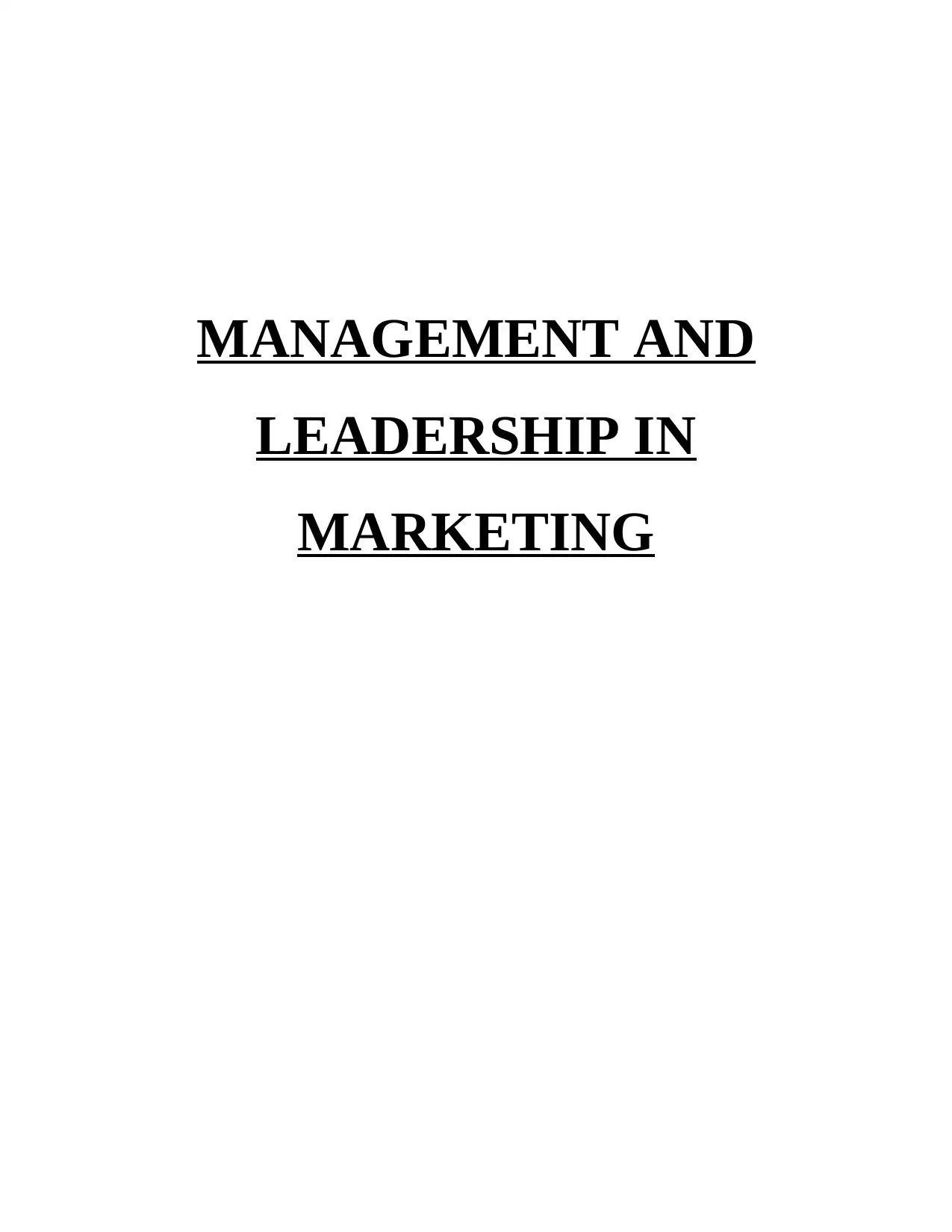
MANAGEMENT AND
LEADERSHIP IN
MARKETING
LEADERSHIP IN
MARKETING
Paraphrase This Document
Need a fresh take? Get an instant paraphrase of this document with our AI Paraphraser
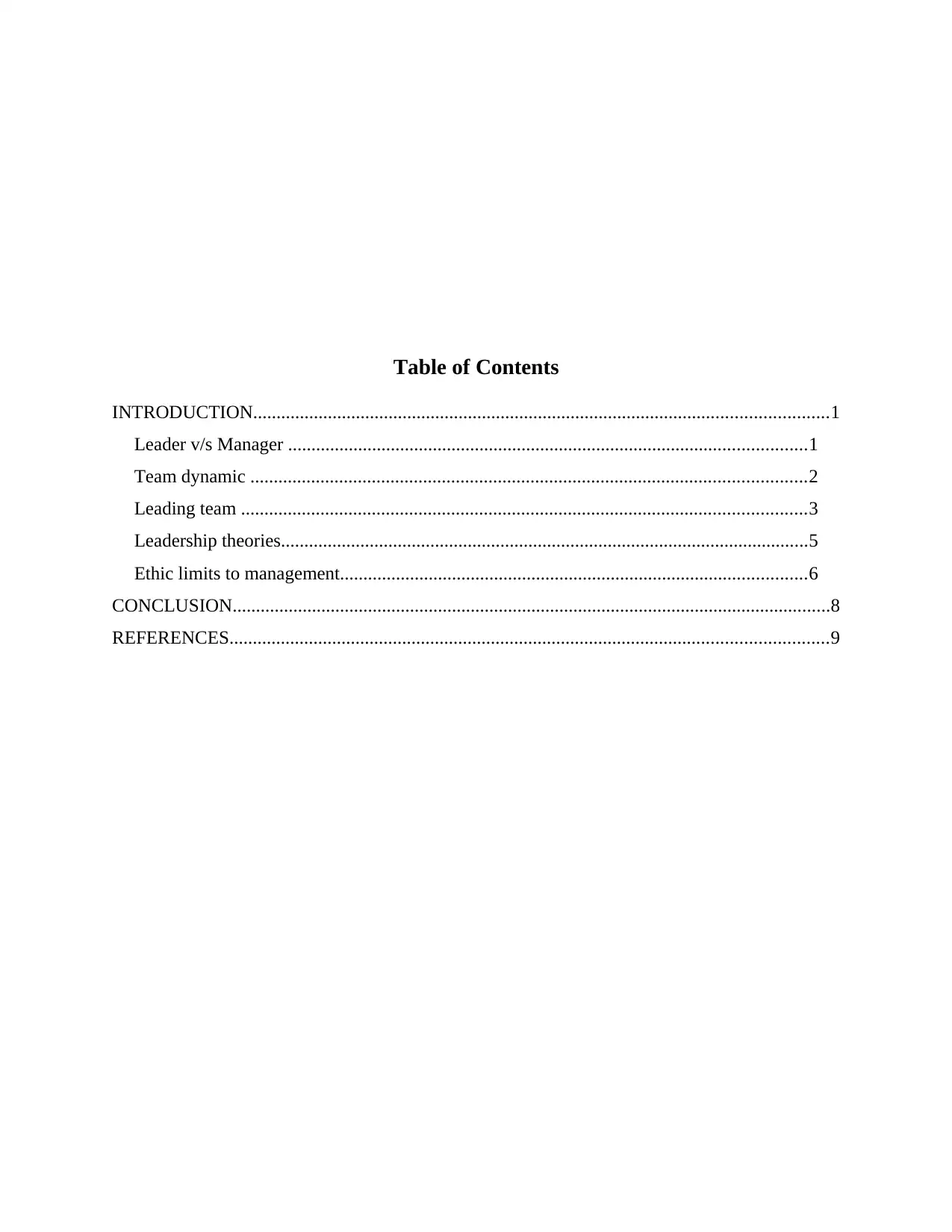
Table of Contents
INTRODUCTION...........................................................................................................................1
Leader v/s Manager ...............................................................................................................1
Team dynamic .......................................................................................................................2
Leading team .........................................................................................................................3
Leadership theories.................................................................................................................5
Ethic limits to management....................................................................................................6
CONCLUSION................................................................................................................................8
REFERENCES................................................................................................................................9
INTRODUCTION...........................................................................................................................1
Leader v/s Manager ...............................................................................................................1
Team dynamic .......................................................................................................................2
Leading team .........................................................................................................................3
Leadership theories.................................................................................................................5
Ethic limits to management....................................................................................................6
CONCLUSION................................................................................................................................8
REFERENCES................................................................................................................................9
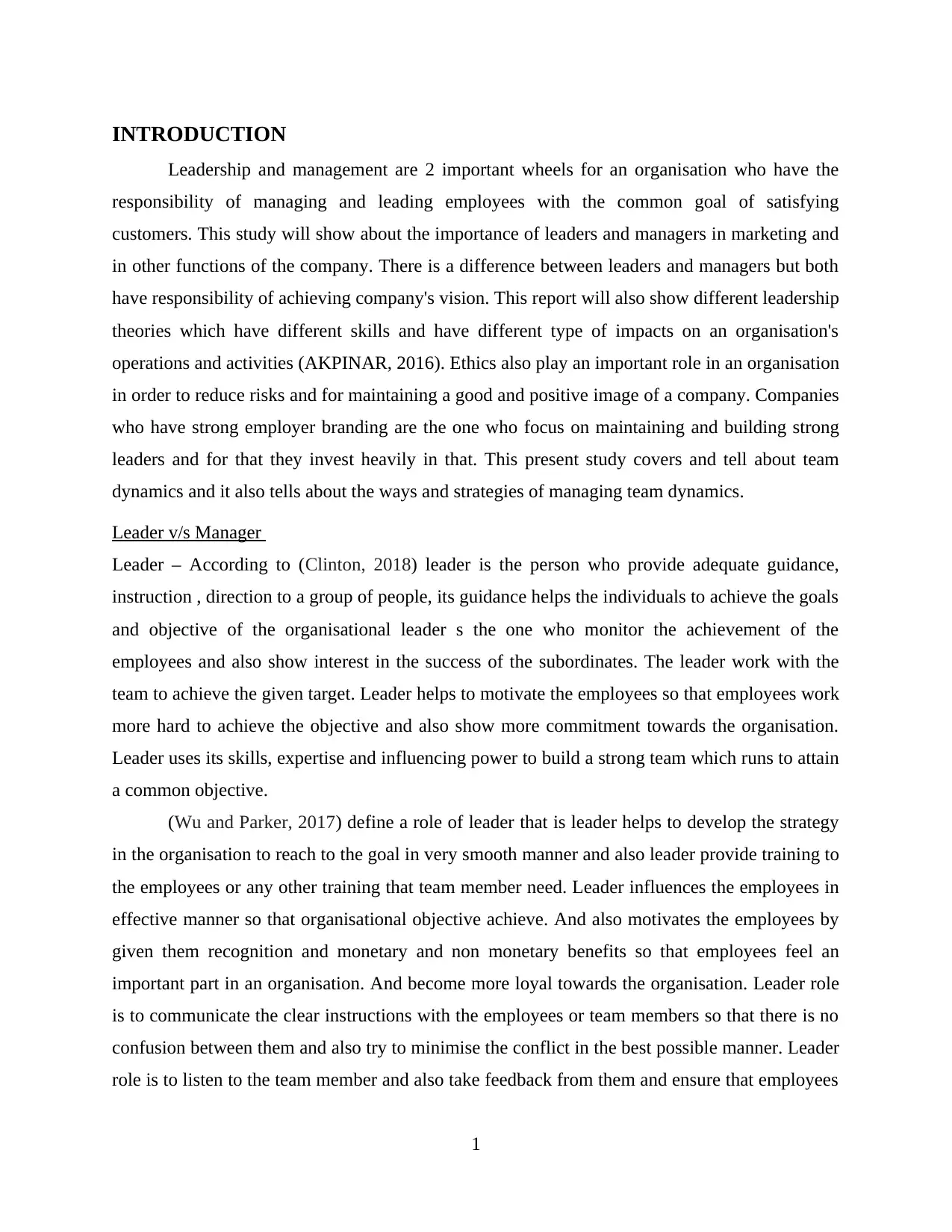
INTRODUCTION
Leadership and management are 2 important wheels for an organisation who have the
responsibility of managing and leading employees with the common goal of satisfying
customers. This study will show about the importance of leaders and managers in marketing and
in other functions of the company. There is a difference between leaders and managers but both
have responsibility of achieving company's vision. This report will also show different leadership
theories which have different skills and have different type of impacts on an organisation's
operations and activities (AKPINAR, 2016). Ethics also play an important role in an organisation
in order to reduce risks and for maintaining a good and positive image of a company. Companies
who have strong employer branding are the one who focus on maintaining and building strong
leaders and for that they invest heavily in that. This present study covers and tell about team
dynamics and it also tells about the ways and strategies of managing team dynamics.
Leader v/s Manager
Leader – According to (Clinton, 2018) leader is the person who provide adequate guidance,
instruction , direction to a group of people, its guidance helps the individuals to achieve the goals
and objective of the organisational leader s the one who monitor the achievement of the
employees and also show interest in the success of the subordinates. The leader work with the
team to achieve the given target. Leader helps to motivate the employees so that employees work
more hard to achieve the objective and also show more commitment towards the organisation.
Leader uses its skills, expertise and influencing power to build a strong team which runs to attain
a common objective.
(Wu and Parker, 2017) define a role of leader that is leader helps to develop the strategy
in the organisation to reach to the goal in very smooth manner and also leader provide training to
the employees or any other training that team member need. Leader influences the employees in
effective manner so that organisational objective achieve. And also motivates the employees by
given them recognition and monetary and non monetary benefits so that employees feel an
important part in an organisation. And become more loyal towards the organisation. Leader role
is to communicate the clear instructions with the employees or team members so that there is no
confusion between them and also try to minimise the conflict in the best possible manner. Leader
role is to listen to the team member and also take feedback from them and ensure that employees
1
Leadership and management are 2 important wheels for an organisation who have the
responsibility of managing and leading employees with the common goal of satisfying
customers. This study will show about the importance of leaders and managers in marketing and
in other functions of the company. There is a difference between leaders and managers but both
have responsibility of achieving company's vision. This report will also show different leadership
theories which have different skills and have different type of impacts on an organisation's
operations and activities (AKPINAR, 2016). Ethics also play an important role in an organisation
in order to reduce risks and for maintaining a good and positive image of a company. Companies
who have strong employer branding are the one who focus on maintaining and building strong
leaders and for that they invest heavily in that. This present study covers and tell about team
dynamics and it also tells about the ways and strategies of managing team dynamics.
Leader v/s Manager
Leader – According to (Clinton, 2018) leader is the person who provide adequate guidance,
instruction , direction to a group of people, its guidance helps the individuals to achieve the goals
and objective of the organisational leader s the one who monitor the achievement of the
employees and also show interest in the success of the subordinates. The leader work with the
team to achieve the given target. Leader helps to motivate the employees so that employees work
more hard to achieve the objective and also show more commitment towards the organisation.
Leader uses its skills, expertise and influencing power to build a strong team which runs to attain
a common objective.
(Wu and Parker, 2017) define a role of leader that is leader helps to develop the strategy
in the organisation to reach to the goal in very smooth manner and also leader provide training to
the employees or any other training that team member need. Leader influences the employees in
effective manner so that organisational objective achieve. And also motivates the employees by
given them recognition and monetary and non monetary benefits so that employees feel an
important part in an organisation. And become more loyal towards the organisation. Leader role
is to communicate the clear instructions with the employees or team members so that there is no
confusion between them and also try to minimise the conflict in the best possible manner. Leader
role is to listen to the team member and also take feedback from them and ensure that employees
1
⊘ This is a preview!⊘
Do you want full access?
Subscribe today to unlock all pages.

Trusted by 1+ million students worldwide
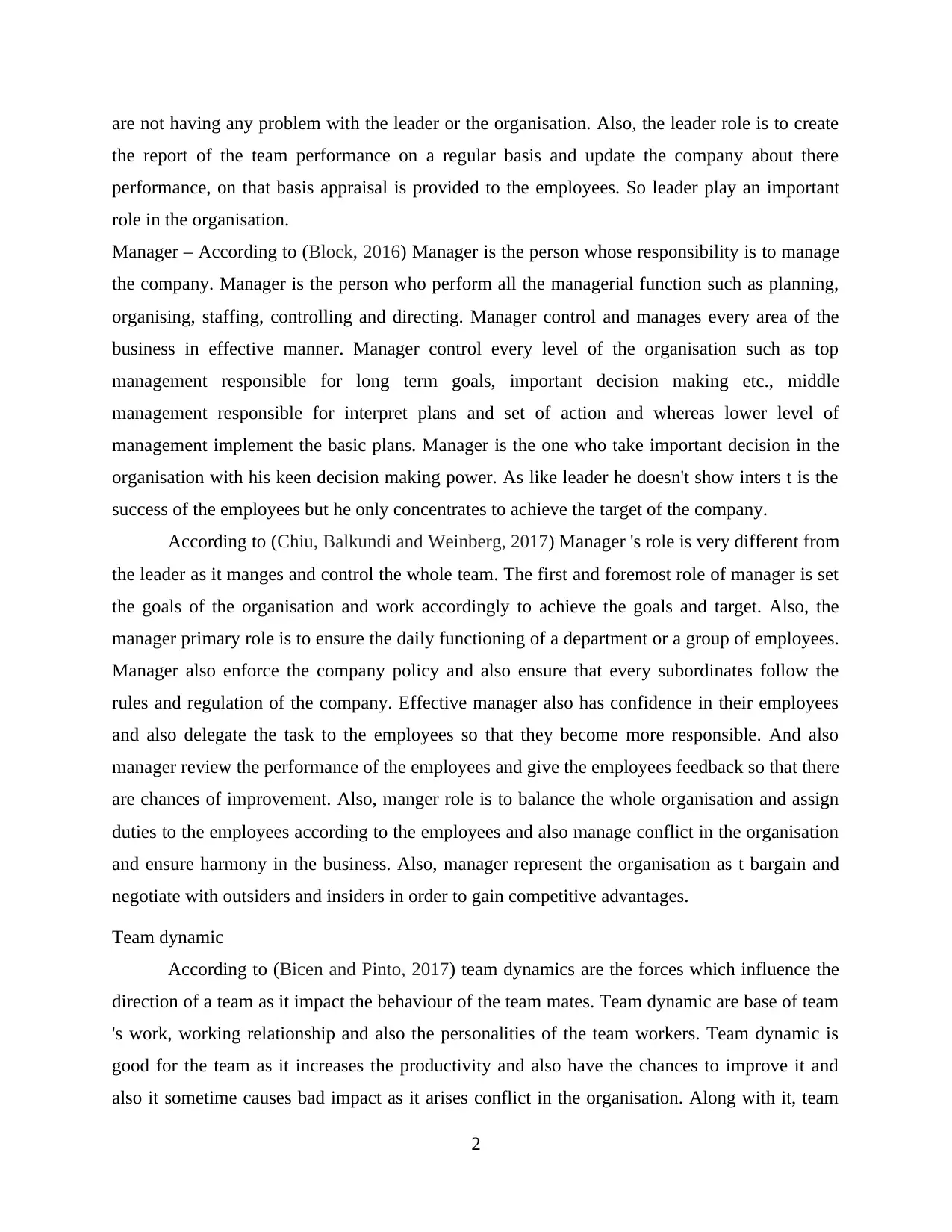
are not having any problem with the leader or the organisation. Also, the leader role is to create
the report of the team performance on a regular basis and update the company about there
performance, on that basis appraisal is provided to the employees. So leader play an important
role in the organisation.
Manager – According to (Block, 2016) Manager is the person whose responsibility is to manage
the company. Manager is the person who perform all the managerial function such as planning,
organising, staffing, controlling and directing. Manager control and manages every area of the
business in effective manner. Manager control every level of the organisation such as top
management responsible for long term goals, important decision making etc., middle
management responsible for interpret plans and set of action and whereas lower level of
management implement the basic plans. Manager is the one who take important decision in the
organisation with his keen decision making power. As like leader he doesn't show inters t is the
success of the employees but he only concentrates to achieve the target of the company.
According to (Chiu, Balkundi and Weinberg, 2017) Manager 's role is very different from
the leader as it manges and control the whole team. The first and foremost role of manager is set
the goals of the organisation and work accordingly to achieve the goals and target. Also, the
manager primary role is to ensure the daily functioning of a department or a group of employees.
Manager also enforce the company policy and also ensure that every subordinates follow the
rules and regulation of the company. Effective manager also has confidence in their employees
and also delegate the task to the employees so that they become more responsible. And also
manager review the performance of the employees and give the employees feedback so that there
are chances of improvement. Also, manger role is to balance the whole organisation and assign
duties to the employees according to the employees and also manage conflict in the organisation
and ensure harmony in the business. Also, manager represent the organisation as t bargain and
negotiate with outsiders and insiders in order to gain competitive advantages.
Team dynamic
According to (Bicen and Pinto, 2017) team dynamics are the forces which influence the
direction of a team as it impact the behaviour of the team mates. Team dynamic are base of team
's work, working relationship and also the personalities of the team workers. Team dynamic is
good for the team as it increases the productivity and also have the chances to improve it and
also it sometime causes bad impact as it arises conflict in the organisation. Along with it, team
2
the report of the team performance on a regular basis and update the company about there
performance, on that basis appraisal is provided to the employees. So leader play an important
role in the organisation.
Manager – According to (Block, 2016) Manager is the person whose responsibility is to manage
the company. Manager is the person who perform all the managerial function such as planning,
organising, staffing, controlling and directing. Manager control and manages every area of the
business in effective manner. Manager control every level of the organisation such as top
management responsible for long term goals, important decision making etc., middle
management responsible for interpret plans and set of action and whereas lower level of
management implement the basic plans. Manager is the one who take important decision in the
organisation with his keen decision making power. As like leader he doesn't show inters t is the
success of the employees but he only concentrates to achieve the target of the company.
According to (Chiu, Balkundi and Weinberg, 2017) Manager 's role is very different from
the leader as it manges and control the whole team. The first and foremost role of manager is set
the goals of the organisation and work accordingly to achieve the goals and target. Also, the
manager primary role is to ensure the daily functioning of a department or a group of employees.
Manager also enforce the company policy and also ensure that every subordinates follow the
rules and regulation of the company. Effective manager also has confidence in their employees
and also delegate the task to the employees so that they become more responsible. And also
manager review the performance of the employees and give the employees feedback so that there
are chances of improvement. Also, manger role is to balance the whole organisation and assign
duties to the employees according to the employees and also manage conflict in the organisation
and ensure harmony in the business. Also, manager represent the organisation as t bargain and
negotiate with outsiders and insiders in order to gain competitive advantages.
Team dynamic
According to (Bicen and Pinto, 2017) team dynamics are the forces which influence the
direction of a team as it impact the behaviour of the team mates. Team dynamic are base of team
's work, working relationship and also the personalities of the team workers. Team dynamic is
good for the team as it increases the productivity and also have the chances to improve it and
also it sometime causes bad impact as it arises conflict in the organisation. Along with it, team
2
Paraphrase This Document
Need a fresh take? Get an instant paraphrase of this document with our AI Paraphraser
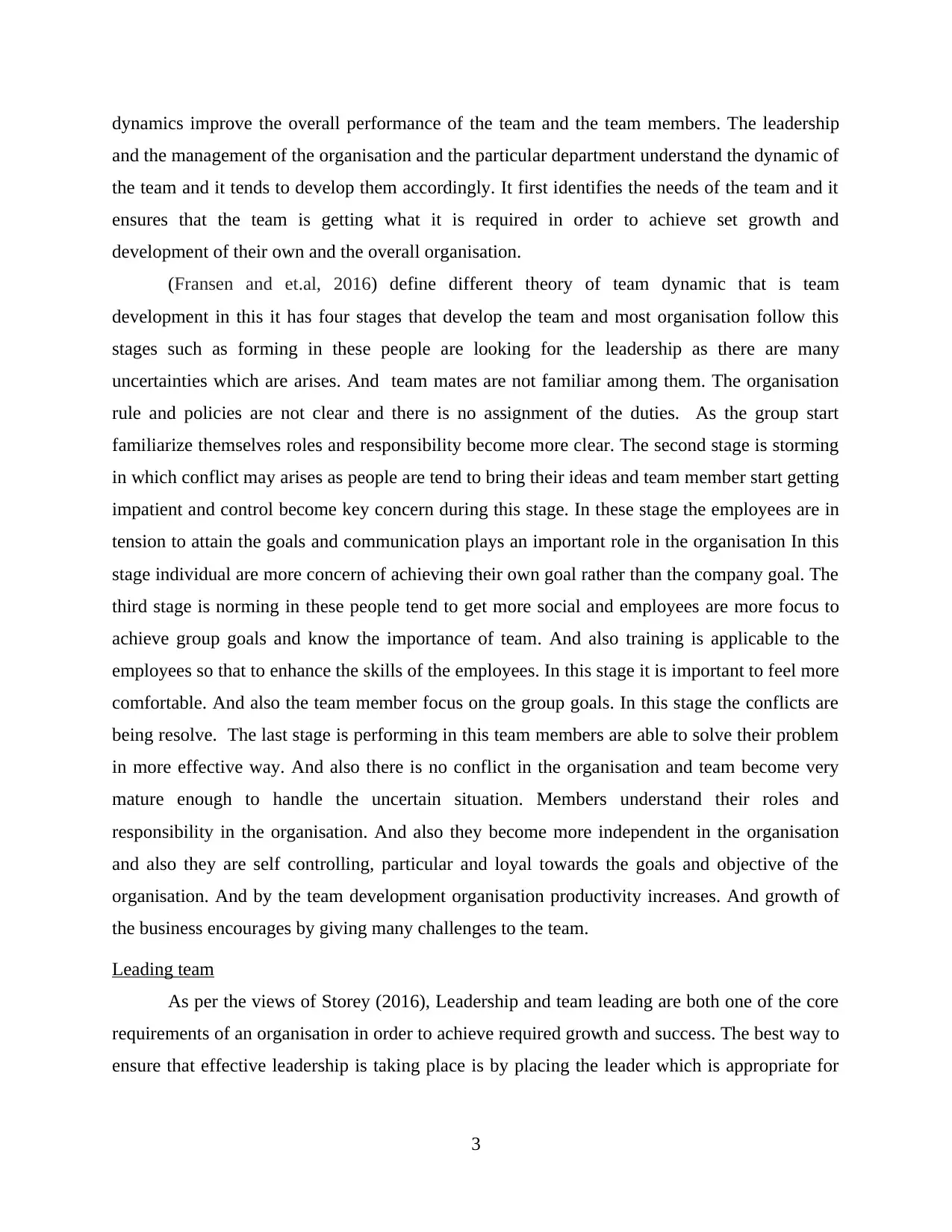
dynamics improve the overall performance of the team and the team members. The leadership
and the management of the organisation and the particular department understand the dynamic of
the team and it tends to develop them accordingly. It first identifies the needs of the team and it
ensures that the team is getting what it is required in order to achieve set growth and
development of their own and the overall organisation.
(Fransen and et.al, 2016) define different theory of team dynamic that is team
development in this it has four stages that develop the team and most organisation follow this
stages such as forming in these people are looking for the leadership as there are many
uncertainties which are arises. And team mates are not familiar among them. The organisation
rule and policies are not clear and there is no assignment of the duties. As the group start
familiarize themselves roles and responsibility become more clear. The second stage is storming
in which conflict may arises as people are tend to bring their ideas and team member start getting
impatient and control become key concern during this stage. In these stage the employees are in
tension to attain the goals and communication plays an important role in the organisation In this
stage individual are more concern of achieving their own goal rather than the company goal. The
third stage is norming in these people tend to get more social and employees are more focus to
achieve group goals and know the importance of team. And also training is applicable to the
employees so that to enhance the skills of the employees. In this stage it is important to feel more
comfortable. And also the team member focus on the group goals. In this stage the conflicts are
being resolve. The last stage is performing in this team members are able to solve their problem
in more effective way. And also there is no conflict in the organisation and team become very
mature enough to handle the uncertain situation. Members understand their roles and
responsibility in the organisation. And also they become more independent in the organisation
and also they are self controlling, particular and loyal towards the goals and objective of the
organisation. And by the team development organisation productivity increases. And growth of
the business encourages by giving many challenges to the team.
Leading team
As per the views of Storey (2016), Leadership and team leading are both one of the core
requirements of an organisation in order to achieve required growth and success. The best way to
ensure that effective leadership is taking place is by placing the leader which is appropriate for
3
and the management of the organisation and the particular department understand the dynamic of
the team and it tends to develop them accordingly. It first identifies the needs of the team and it
ensures that the team is getting what it is required in order to achieve set growth and
development of their own and the overall organisation.
(Fransen and et.al, 2016) define different theory of team dynamic that is team
development in this it has four stages that develop the team and most organisation follow this
stages such as forming in these people are looking for the leadership as there are many
uncertainties which are arises. And team mates are not familiar among them. The organisation
rule and policies are not clear and there is no assignment of the duties. As the group start
familiarize themselves roles and responsibility become more clear. The second stage is storming
in which conflict may arises as people are tend to bring their ideas and team member start getting
impatient and control become key concern during this stage. In these stage the employees are in
tension to attain the goals and communication plays an important role in the organisation In this
stage individual are more concern of achieving their own goal rather than the company goal. The
third stage is norming in these people tend to get more social and employees are more focus to
achieve group goals and know the importance of team. And also training is applicable to the
employees so that to enhance the skills of the employees. In this stage it is important to feel more
comfortable. And also the team member focus on the group goals. In this stage the conflicts are
being resolve. The last stage is performing in this team members are able to solve their problem
in more effective way. And also there is no conflict in the organisation and team become very
mature enough to handle the uncertain situation. Members understand their roles and
responsibility in the organisation. And also they become more independent in the organisation
and also they are self controlling, particular and loyal towards the goals and objective of the
organisation. And by the team development organisation productivity increases. And growth of
the business encourages by giving many challenges to the team.
Leading team
As per the views of Storey (2016), Leadership and team leading are both one of the core
requirements of an organisation in order to achieve required growth and success. The best way to
ensure that effective leadership is taking place is by placing the leader which is appropriate for
3
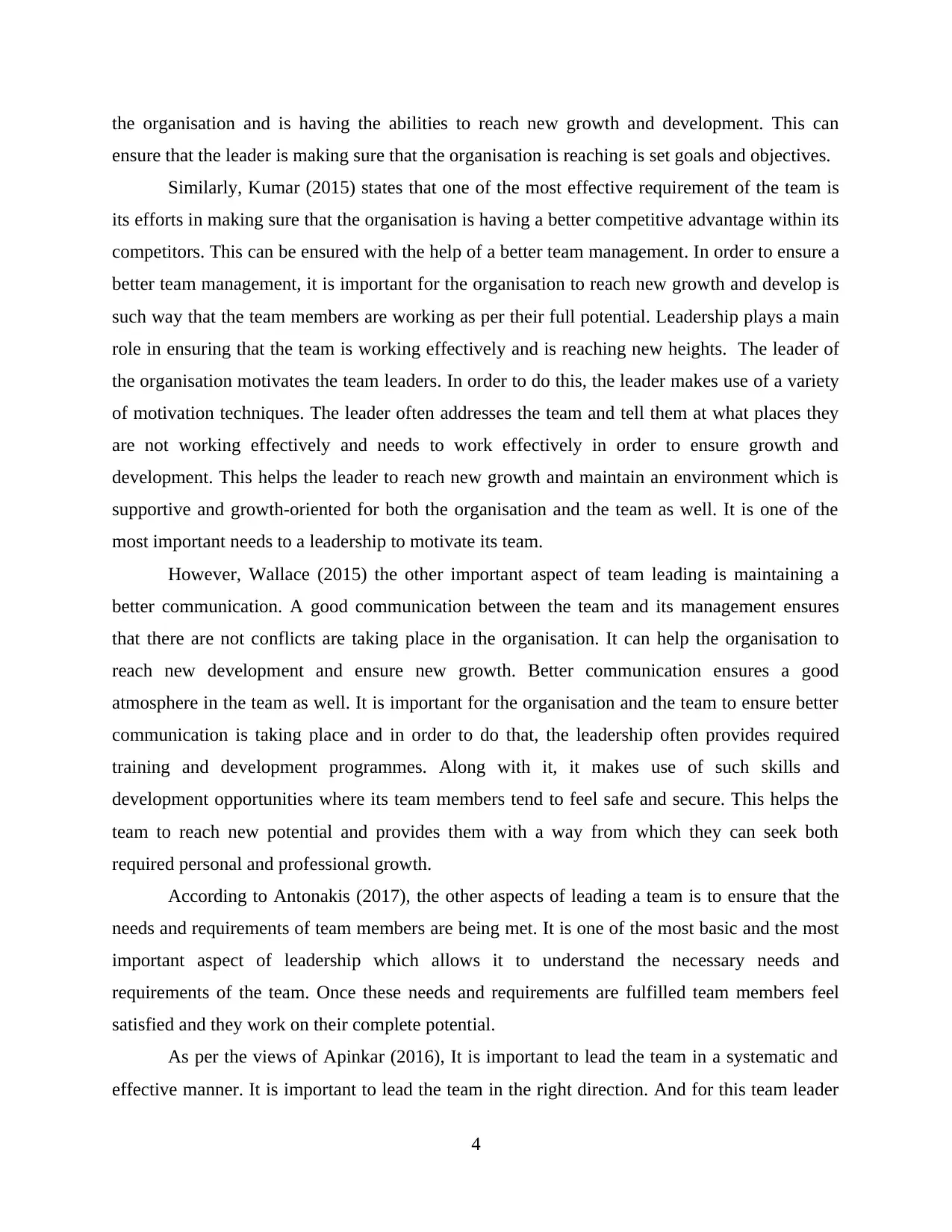
the organisation and is having the abilities to reach new growth and development. This can
ensure that the leader is making sure that the organisation is reaching is set goals and objectives.
Similarly, Kumar (2015) states that one of the most effective requirement of the team is
its efforts in making sure that the organisation is having a better competitive advantage within its
competitors. This can be ensured with the help of a better team management. In order to ensure a
better team management, it is important for the organisation to reach new growth and develop is
such way that the team members are working as per their full potential. Leadership plays a main
role in ensuring that the team is working effectively and is reaching new heights. The leader of
the organisation motivates the team leaders. In order to do this, the leader makes use of a variety
of motivation techniques. The leader often addresses the team and tell them at what places they
are not working effectively and needs to work effectively in order to ensure growth and
development. This helps the leader to reach new growth and maintain an environment which is
supportive and growth-oriented for both the organisation and the team as well. It is one of the
most important needs to a leadership to motivate its team.
However, Wallace (2015) the other important aspect of team leading is maintaining a
better communication. A good communication between the team and its management ensures
that there are not conflicts are taking place in the organisation. It can help the organisation to
reach new development and ensure new growth. Better communication ensures a good
atmosphere in the team as well. It is important for the organisation and the team to ensure better
communication is taking place and in order to do that, the leadership often provides required
training and development programmes. Along with it, it makes use of such skills and
development opportunities where its team members tend to feel safe and secure. This helps the
team to reach new potential and provides them with a way from which they can seek both
required personal and professional growth.
According to Antonakis (2017), the other aspects of leading a team is to ensure that the
needs and requirements of team members are being met. It is one of the most basic and the most
important aspect of leadership which allows it to understand the necessary needs and
requirements of the team. Once these needs and requirements are fulfilled team members feel
satisfied and they work on their complete potential.
As per the views of Apinkar (2016), It is important to lead the team in a systematic and
effective manner. It is important to lead the team in the right direction. And for this team leader
4
ensure that the leader is making sure that the organisation is reaching is set goals and objectives.
Similarly, Kumar (2015) states that one of the most effective requirement of the team is
its efforts in making sure that the organisation is having a better competitive advantage within its
competitors. This can be ensured with the help of a better team management. In order to ensure a
better team management, it is important for the organisation to reach new growth and develop is
such way that the team members are working as per their full potential. Leadership plays a main
role in ensuring that the team is working effectively and is reaching new heights. The leader of
the organisation motivates the team leaders. In order to do this, the leader makes use of a variety
of motivation techniques. The leader often addresses the team and tell them at what places they
are not working effectively and needs to work effectively in order to ensure growth and
development. This helps the leader to reach new growth and maintain an environment which is
supportive and growth-oriented for both the organisation and the team as well. It is one of the
most important needs to a leadership to motivate its team.
However, Wallace (2015) the other important aspect of team leading is maintaining a
better communication. A good communication between the team and its management ensures
that there are not conflicts are taking place in the organisation. It can help the organisation to
reach new development and ensure new growth. Better communication ensures a good
atmosphere in the team as well. It is important for the organisation and the team to ensure better
communication is taking place and in order to do that, the leadership often provides required
training and development programmes. Along with it, it makes use of such skills and
development opportunities where its team members tend to feel safe and secure. This helps the
team to reach new potential and provides them with a way from which they can seek both
required personal and professional growth.
According to Antonakis (2017), the other aspects of leading a team is to ensure that the
needs and requirements of team members are being met. It is one of the most basic and the most
important aspect of leadership which allows it to understand the necessary needs and
requirements of the team. Once these needs and requirements are fulfilled team members feel
satisfied and they work on their complete potential.
As per the views of Apinkar (2016), It is important to lead the team in a systematic and
effective manner. It is important to lead the team in the right direction. And for this team leader
4
⊘ This is a preview!⊘
Do you want full access?
Subscribe today to unlock all pages.

Trusted by 1+ million students worldwide
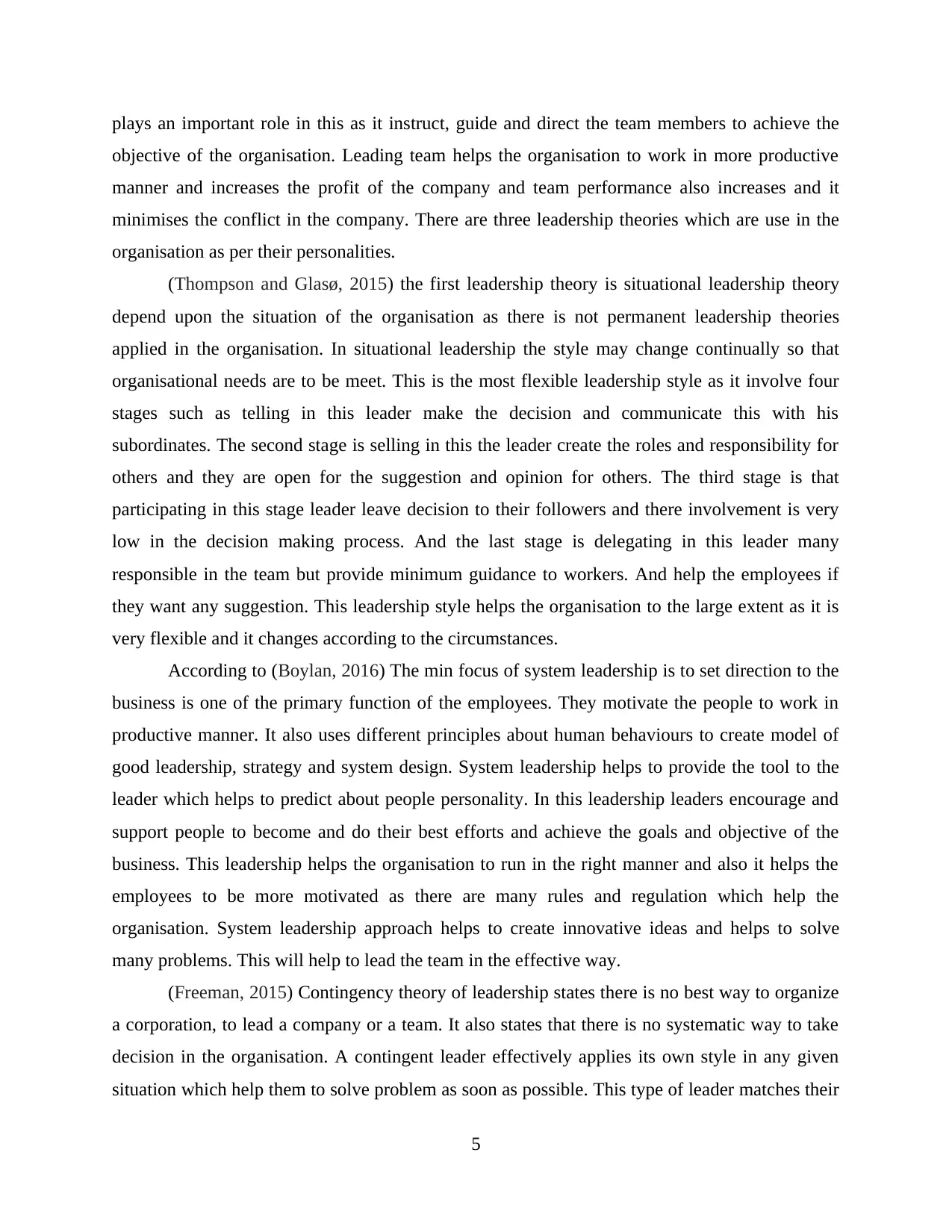
plays an important role in this as it instruct, guide and direct the team members to achieve the
objective of the organisation. Leading team helps the organisation to work in more productive
manner and increases the profit of the company and team performance also increases and it
minimises the conflict in the company. There are three leadership theories which are use in the
organisation as per their personalities.
(Thompson and Glasø, 2015) the first leadership theory is situational leadership theory
depend upon the situation of the organisation as there is not permanent leadership theories
applied in the organisation. In situational leadership the style may change continually so that
organisational needs are to be meet. This is the most flexible leadership style as it involve four
stages such as telling in this leader make the decision and communicate this with his
subordinates. The second stage is selling in this the leader create the roles and responsibility for
others and they are open for the suggestion and opinion for others. The third stage is that
participating in this stage leader leave decision to their followers and there involvement is very
low in the decision making process. And the last stage is delegating in this leader many
responsible in the team but provide minimum guidance to workers. And help the employees if
they want any suggestion. This leadership style helps the organisation to the large extent as it is
very flexible and it changes according to the circumstances.
According to (Boylan, 2016) The min focus of system leadership is to set direction to the
business is one of the primary function of the employees. They motivate the people to work in
productive manner. It also uses different principles about human behaviours to create model of
good leadership, strategy and system design. System leadership helps to provide the tool to the
leader which helps to predict about people personality. In this leadership leaders encourage and
support people to become and do their best efforts and achieve the goals and objective of the
business. This leadership helps the organisation to run in the right manner and also it helps the
employees to be more motivated as there are many rules and regulation which help the
organisation. System leadership approach helps to create innovative ideas and helps to solve
many problems. This will help to lead the team in the effective way.
(Freeman, 2015) Contingency theory of leadership states there is no best way to organize
a corporation, to lead a company or a team. It also states that there is no systematic way to take
decision in the organisation. A contingent leader effectively applies its own style in any given
situation which help them to solve problem as soon as possible. This type of leader matches their
5
objective of the organisation. Leading team helps the organisation to work in more productive
manner and increases the profit of the company and team performance also increases and it
minimises the conflict in the company. There are three leadership theories which are use in the
organisation as per their personalities.
(Thompson and Glasø, 2015) the first leadership theory is situational leadership theory
depend upon the situation of the organisation as there is not permanent leadership theories
applied in the organisation. In situational leadership the style may change continually so that
organisational needs are to be meet. This is the most flexible leadership style as it involve four
stages such as telling in this leader make the decision and communicate this with his
subordinates. The second stage is selling in this the leader create the roles and responsibility for
others and they are open for the suggestion and opinion for others. The third stage is that
participating in this stage leader leave decision to their followers and there involvement is very
low in the decision making process. And the last stage is delegating in this leader many
responsible in the team but provide minimum guidance to workers. And help the employees if
they want any suggestion. This leadership style helps the organisation to the large extent as it is
very flexible and it changes according to the circumstances.
According to (Boylan, 2016) The min focus of system leadership is to set direction to the
business is one of the primary function of the employees. They motivate the people to work in
productive manner. It also uses different principles about human behaviours to create model of
good leadership, strategy and system design. System leadership helps to provide the tool to the
leader which helps to predict about people personality. In this leadership leaders encourage and
support people to become and do their best efforts and achieve the goals and objective of the
business. This leadership helps the organisation to run in the right manner and also it helps the
employees to be more motivated as there are many rules and regulation which help the
organisation. System leadership approach helps to create innovative ideas and helps to solve
many problems. This will help to lead the team in the effective way.
(Freeman, 2015) Contingency theory of leadership states there is no best way to organize
a corporation, to lead a company or a team. It also states that there is no systematic way to take
decision in the organisation. A contingent leader effectively applies its own style in any given
situation which help them to solve problem as soon as possible. This type of leader matches their
5
Paraphrase This Document
Need a fresh take? Get an instant paraphrase of this document with our AI Paraphraser
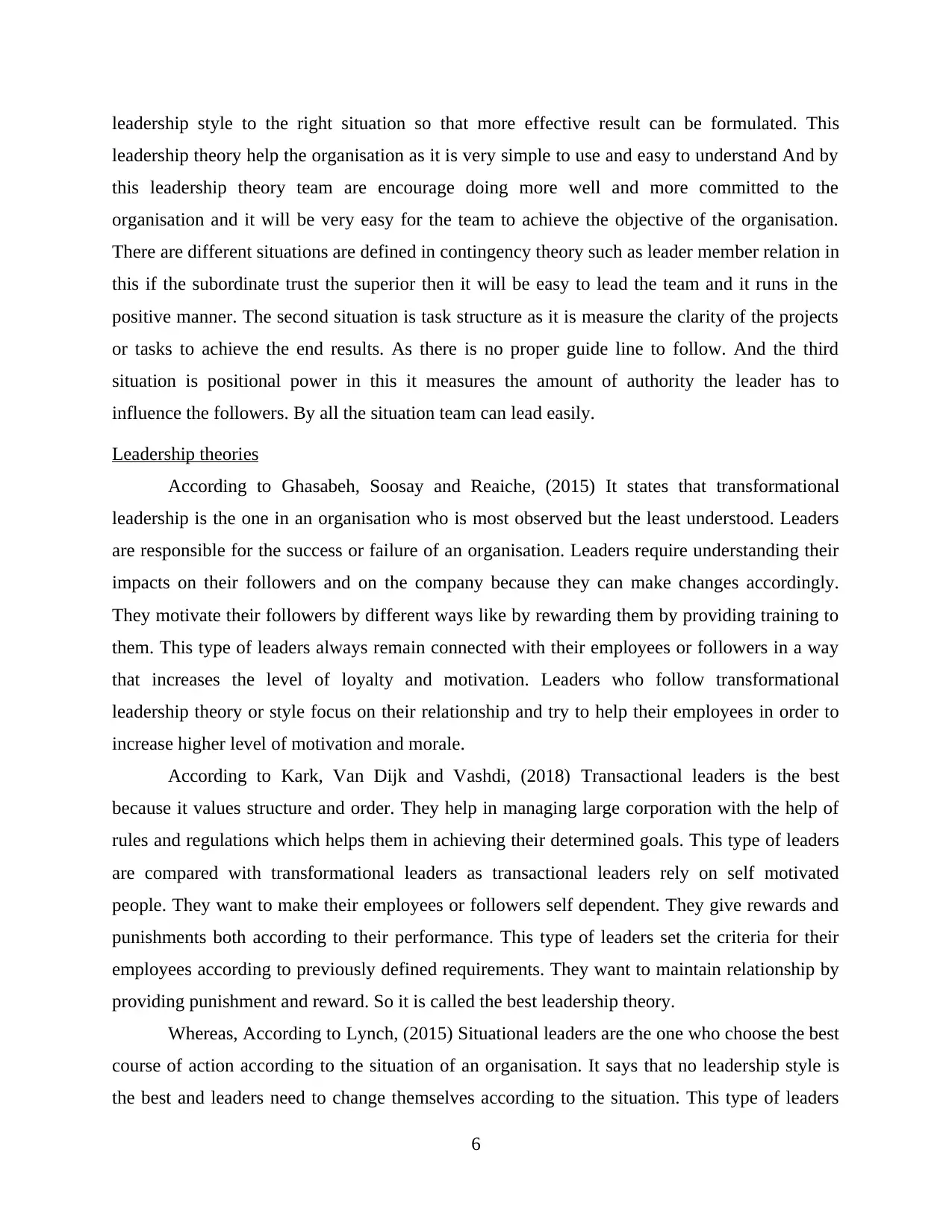
leadership style to the right situation so that more effective result can be formulated. This
leadership theory help the organisation as it is very simple to use and easy to understand And by
this leadership theory team are encourage doing more well and more committed to the
organisation and it will be very easy for the team to achieve the objective of the organisation.
There are different situations are defined in contingency theory such as leader member relation in
this if the subordinate trust the superior then it will be easy to lead the team and it runs in the
positive manner. The second situation is task structure as it is measure the clarity of the projects
or tasks to achieve the end results. As there is no proper guide line to follow. And the third
situation is positional power in this it measures the amount of authority the leader has to
influence the followers. By all the situation team can lead easily.
Leadership theories
According to Ghasabeh, Soosay and Reaiche, (2015) It states that transformational
leadership is the one in an organisation who is most observed but the least understood. Leaders
are responsible for the success or failure of an organisation. Leaders require understanding their
impacts on their followers and on the company because they can make changes accordingly.
They motivate their followers by different ways like by rewarding them by providing training to
them. This type of leaders always remain connected with their employees or followers in a way
that increases the level of loyalty and motivation. Leaders who follow transformational
leadership theory or style focus on their relationship and try to help their employees in order to
increase higher level of motivation and morale.
According to Kark, Van Dijk and Vashdi, (2018) Transactional leaders is the best
because it values structure and order. They help in managing large corporation with the help of
rules and regulations which helps them in achieving their determined goals. This type of leaders
are compared with transformational leaders as transactional leaders rely on self motivated
people. They want to make their employees or followers self dependent. They give rewards and
punishments both according to their performance. This type of leaders set the criteria for their
employees according to previously defined requirements. They want to maintain relationship by
providing punishment and reward. So it is called the best leadership theory.
Whereas, According to Lynch, (2015) Situational leaders are the one who choose the best
course of action according to the situation of an organisation. It says that no leadership style is
the best and leaders need to change themselves according to the situation. This type of leaders
6
leadership theory help the organisation as it is very simple to use and easy to understand And by
this leadership theory team are encourage doing more well and more committed to the
organisation and it will be very easy for the team to achieve the objective of the organisation.
There are different situations are defined in contingency theory such as leader member relation in
this if the subordinate trust the superior then it will be easy to lead the team and it runs in the
positive manner. The second situation is task structure as it is measure the clarity of the projects
or tasks to achieve the end results. As there is no proper guide line to follow. And the third
situation is positional power in this it measures the amount of authority the leader has to
influence the followers. By all the situation team can lead easily.
Leadership theories
According to Ghasabeh, Soosay and Reaiche, (2015) It states that transformational
leadership is the one in an organisation who is most observed but the least understood. Leaders
are responsible for the success or failure of an organisation. Leaders require understanding their
impacts on their followers and on the company because they can make changes accordingly.
They motivate their followers by different ways like by rewarding them by providing training to
them. This type of leaders always remain connected with their employees or followers in a way
that increases the level of loyalty and motivation. Leaders who follow transformational
leadership theory or style focus on their relationship and try to help their employees in order to
increase higher level of motivation and morale.
According to Kark, Van Dijk and Vashdi, (2018) Transactional leaders is the best
because it values structure and order. They help in managing large corporation with the help of
rules and regulations which helps them in achieving their determined goals. This type of leaders
are compared with transformational leaders as transactional leaders rely on self motivated
people. They want to make their employees or followers self dependent. They give rewards and
punishments both according to their performance. This type of leaders set the criteria for their
employees according to previously defined requirements. They want to maintain relationship by
providing punishment and reward. So it is called the best leadership theory.
Whereas, According to Lynch, (2015) Situational leaders are the one who choose the best
course of action according to the situation of an organisation. It says that no leadership style is
the best and leaders need to change themselves according to the situation. This type of leaders
6
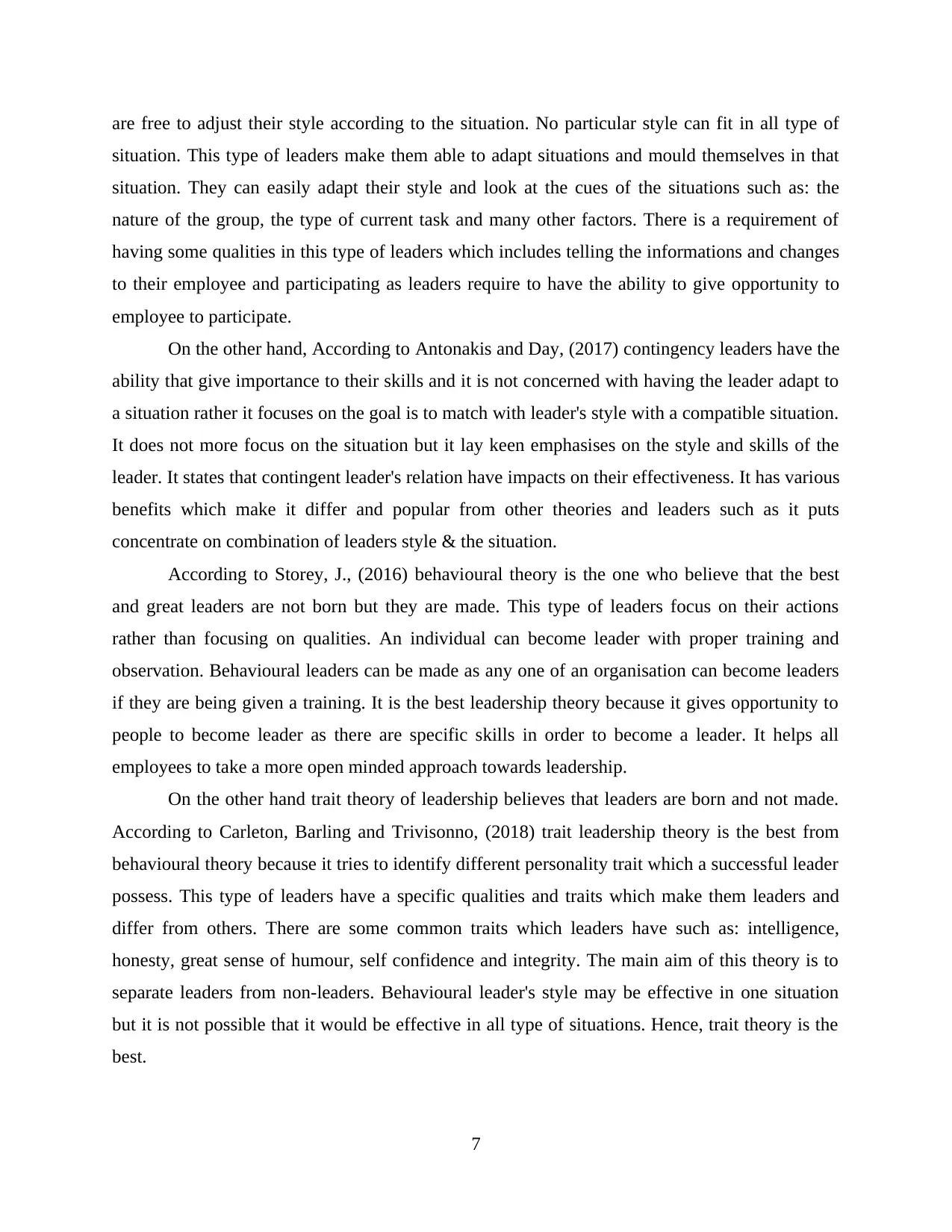
are free to adjust their style according to the situation. No particular style can fit in all type of
situation. This type of leaders make them able to adapt situations and mould themselves in that
situation. They can easily adapt their style and look at the cues of the situations such as: the
nature of the group, the type of current task and many other factors. There is a requirement of
having some qualities in this type of leaders which includes telling the informations and changes
to their employee and participating as leaders require to have the ability to give opportunity to
employee to participate.
On the other hand, According to Antonakis and Day, (2017) contingency leaders have the
ability that give importance to their skills and it is not concerned with having the leader adapt to
a situation rather it focuses on the goal is to match with leader's style with a compatible situation.
It does not more focus on the situation but it lay keen emphasises on the style and skills of the
leader. It states that contingent leader's relation have impacts on their effectiveness. It has various
benefits which make it differ and popular from other theories and leaders such as it puts
concentrate on combination of leaders style & the situation.
According to Storey, J., (2016) behavioural theory is the one who believe that the best
and great leaders are not born but they are made. This type of leaders focus on their actions
rather than focusing on qualities. An individual can become leader with proper training and
observation. Behavioural leaders can be made as any one of an organisation can become leaders
if they are being given a training. It is the best leadership theory because it gives opportunity to
people to become leader as there are specific skills in order to become a leader. It helps all
employees to take a more open minded approach towards leadership.
On the other hand trait theory of leadership believes that leaders are born and not made.
According to Carleton, Barling and Trivisonno, (2018) trait leadership theory is the best from
behavioural theory because it tries to identify different personality trait which a successful leader
possess. This type of leaders have a specific qualities and traits which make them leaders and
differ from others. There are some common traits which leaders have such as: intelligence,
honesty, great sense of humour, self confidence and integrity. The main aim of this theory is to
separate leaders from non-leaders. Behavioural leader's style may be effective in one situation
but it is not possible that it would be effective in all type of situations. Hence, trait theory is the
best.
7
situation. This type of leaders make them able to adapt situations and mould themselves in that
situation. They can easily adapt their style and look at the cues of the situations such as: the
nature of the group, the type of current task and many other factors. There is a requirement of
having some qualities in this type of leaders which includes telling the informations and changes
to their employee and participating as leaders require to have the ability to give opportunity to
employee to participate.
On the other hand, According to Antonakis and Day, (2017) contingency leaders have the
ability that give importance to their skills and it is not concerned with having the leader adapt to
a situation rather it focuses on the goal is to match with leader's style with a compatible situation.
It does not more focus on the situation but it lay keen emphasises on the style and skills of the
leader. It states that contingent leader's relation have impacts on their effectiveness. It has various
benefits which make it differ and popular from other theories and leaders such as it puts
concentrate on combination of leaders style & the situation.
According to Storey, J., (2016) behavioural theory is the one who believe that the best
and great leaders are not born but they are made. This type of leaders focus on their actions
rather than focusing on qualities. An individual can become leader with proper training and
observation. Behavioural leaders can be made as any one of an organisation can become leaders
if they are being given a training. It is the best leadership theory because it gives opportunity to
people to become leader as there are specific skills in order to become a leader. It helps all
employees to take a more open minded approach towards leadership.
On the other hand trait theory of leadership believes that leaders are born and not made.
According to Carleton, Barling and Trivisonno, (2018) trait leadership theory is the best from
behavioural theory because it tries to identify different personality trait which a successful leader
possess. This type of leaders have a specific qualities and traits which make them leaders and
differ from others. There are some common traits which leaders have such as: intelligence,
honesty, great sense of humour, self confidence and integrity. The main aim of this theory is to
separate leaders from non-leaders. Behavioural leader's style may be effective in one situation
but it is not possible that it would be effective in all type of situations. Hence, trait theory is the
best.
7
⊘ This is a preview!⊘
Do you want full access?
Subscribe today to unlock all pages.

Trusted by 1+ million students worldwide
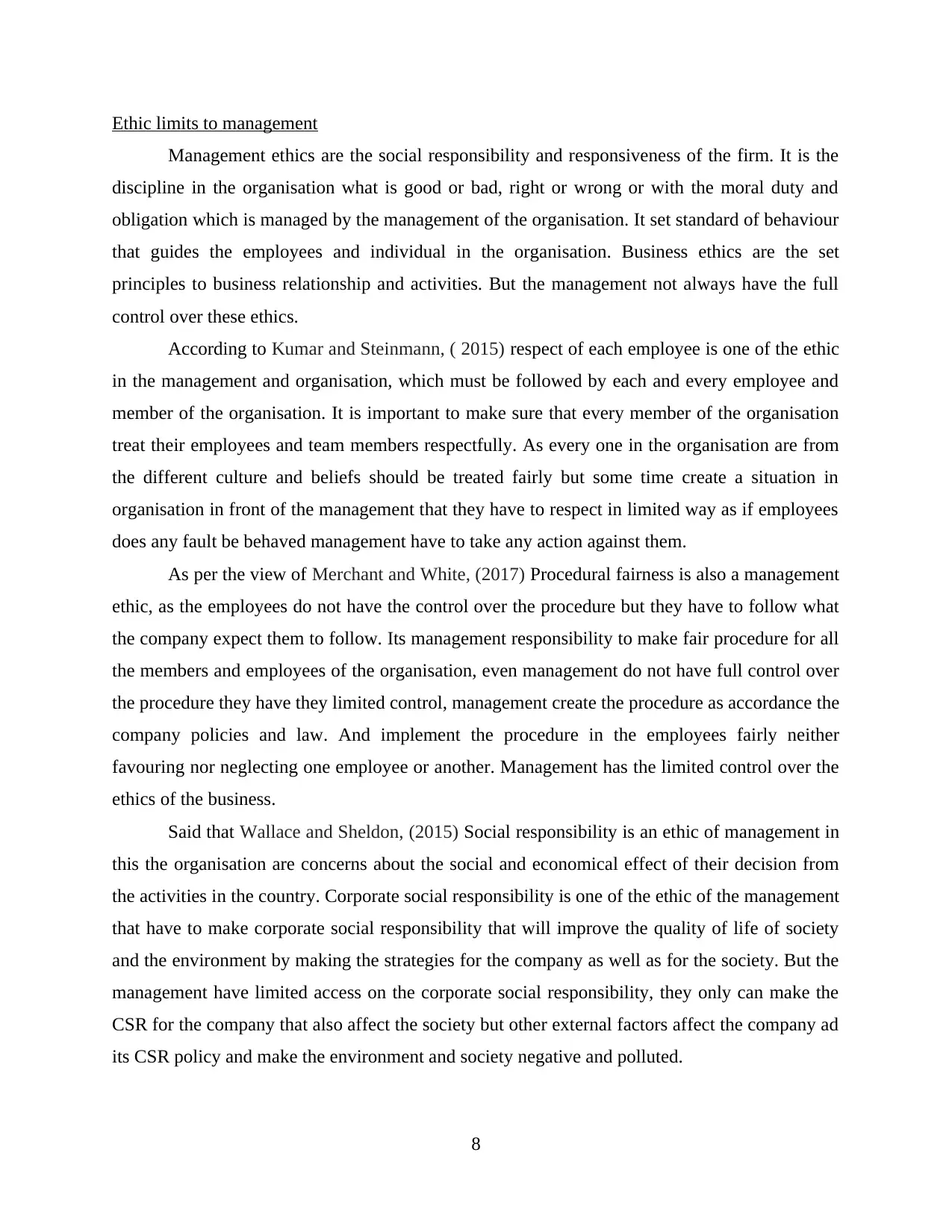
Ethic limits to management
Management ethics are the social responsibility and responsiveness of the firm. It is the
discipline in the organisation what is good or bad, right or wrong or with the moral duty and
obligation which is managed by the management of the organisation. It set standard of behaviour
that guides the employees and individual in the organisation. Business ethics are the set
principles to business relationship and activities. But the management not always have the full
control over these ethics.
According to Kumar and Steinmann, ( 2015) respect of each employee is one of the ethic
in the management and organisation, which must be followed by each and every employee and
member of the organisation. It is important to make sure that every member of the organisation
treat their employees and team members respectfully. As every one in the organisation are from
the different culture and beliefs should be treated fairly but some time create a situation in
organisation in front of the management that they have to respect in limited way as if employees
does any fault be behaved management have to take any action against them.
As per the view of Merchant and White, (2017) Procedural fairness is also a management
ethic, as the employees do not have the control over the procedure but they have to follow what
the company expect them to follow. Its management responsibility to make fair procedure for all
the members and employees of the organisation, even management do not have full control over
the procedure they have they limited control, management create the procedure as accordance the
company policies and law. And implement the procedure in the employees fairly neither
favouring nor neglecting one employee or another. Management has the limited control over the
ethics of the business.
Said that Wallace and Sheldon, (2015) Social responsibility is an ethic of management in
this the organisation are concerns about the social and economical effect of their decision from
the activities in the country. Corporate social responsibility is one of the ethic of the management
that have to make corporate social responsibility that will improve the quality of life of society
and the environment by making the strategies for the company as well as for the society. But the
management have limited access on the corporate social responsibility, they only can make the
CSR for the company that also affect the society but other external factors affect the company ad
its CSR policy and make the environment and society negative and polluted.
8
Management ethics are the social responsibility and responsiveness of the firm. It is the
discipline in the organisation what is good or bad, right or wrong or with the moral duty and
obligation which is managed by the management of the organisation. It set standard of behaviour
that guides the employees and individual in the organisation. Business ethics are the set
principles to business relationship and activities. But the management not always have the full
control over these ethics.
According to Kumar and Steinmann, ( 2015) respect of each employee is one of the ethic
in the management and organisation, which must be followed by each and every employee and
member of the organisation. It is important to make sure that every member of the organisation
treat their employees and team members respectfully. As every one in the organisation are from
the different culture and beliefs should be treated fairly but some time create a situation in
organisation in front of the management that they have to respect in limited way as if employees
does any fault be behaved management have to take any action against them.
As per the view of Merchant and White, (2017) Procedural fairness is also a management
ethic, as the employees do not have the control over the procedure but they have to follow what
the company expect them to follow. Its management responsibility to make fair procedure for all
the members and employees of the organisation, even management do not have full control over
the procedure they have they limited control, management create the procedure as accordance the
company policies and law. And implement the procedure in the employees fairly neither
favouring nor neglecting one employee or another. Management has the limited control over the
ethics of the business.
Said that Wallace and Sheldon, (2015) Social responsibility is an ethic of management in
this the organisation are concerns about the social and economical effect of their decision from
the activities in the country. Corporate social responsibility is one of the ethic of the management
that have to make corporate social responsibility that will improve the quality of life of society
and the environment by making the strategies for the company as well as for the society. But the
management have limited access on the corporate social responsibility, they only can make the
CSR for the company that also affect the society but other external factors affect the company ad
its CSR policy and make the environment and society negative and polluted.
8
Paraphrase This Document
Need a fresh take? Get an instant paraphrase of this document with our AI Paraphraser
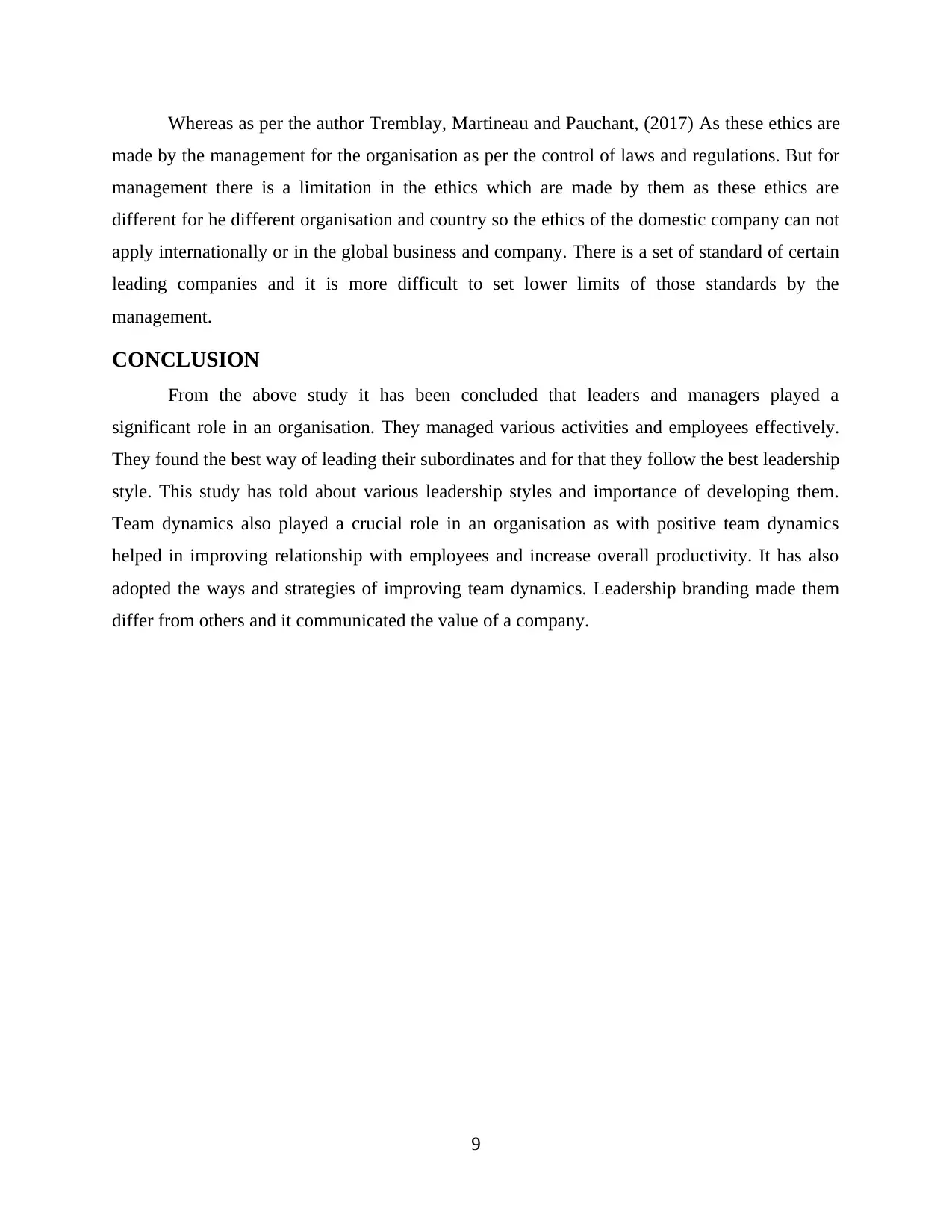
Whereas as per the author Tremblay, Martineau and Pauchant, (2017) As these ethics are
made by the management for the organisation as per the control of laws and regulations. But for
management there is a limitation in the ethics which are made by them as these ethics are
different for he different organisation and country so the ethics of the domestic company can not
apply internationally or in the global business and company. There is a set of standard of certain
leading companies and it is more difficult to set lower limits of those standards by the
management.
CONCLUSION
From the above study it has been concluded that leaders and managers played a
significant role in an organisation. They managed various activities and employees effectively.
They found the best way of leading their subordinates and for that they follow the best leadership
style. This study has told about various leadership styles and importance of developing them.
Team dynamics also played a crucial role in an organisation as with positive team dynamics
helped in improving relationship with employees and increase overall productivity. It has also
adopted the ways and strategies of improving team dynamics. Leadership branding made them
differ from others and it communicated the value of a company.
9
made by the management for the organisation as per the control of laws and regulations. But for
management there is a limitation in the ethics which are made by them as these ethics are
different for he different organisation and country so the ethics of the domestic company can not
apply internationally or in the global business and company. There is a set of standard of certain
leading companies and it is more difficult to set lower limits of those standards by the
management.
CONCLUSION
From the above study it has been concluded that leaders and managers played a
significant role in an organisation. They managed various activities and employees effectively.
They found the best way of leading their subordinates and for that they follow the best leadership
style. This study has told about various leadership styles and importance of developing them.
Team dynamics also played a crucial role in an organisation as with positive team dynamics
helped in improving relationship with employees and increase overall productivity. It has also
adopted the ways and strategies of improving team dynamics. Leadership branding made them
differ from others and it communicated the value of a company.
9
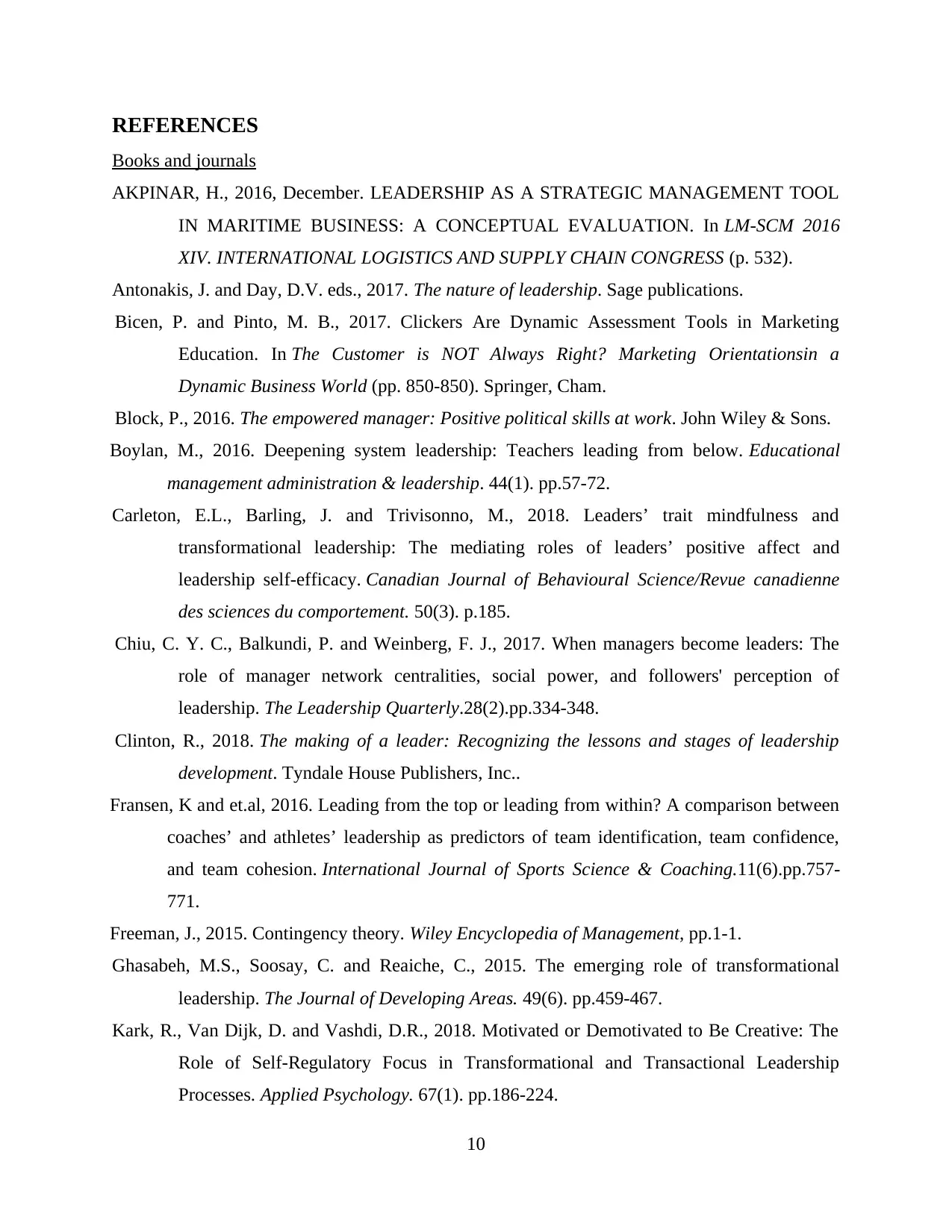
REFERENCES
Books and journals
AKPINAR, H., 2016, December. LEADERSHIP AS A STRATEGIC MANAGEMENT TOOL
IN MARITIME BUSINESS: A CONCEPTUAL EVALUATION. In LM-SCM 2016
XIV. INTERNATIONAL LOGISTICS AND SUPPLY CHAIN CONGRESS (p. 532).
Antonakis, J. and Day, D.V. eds., 2017. The nature of leadership. Sage publications.
Bicen, P. and Pinto, M. B., 2017. Clickers Are Dynamic Assessment Tools in Marketing
Education. In The Customer is NOT Always Right? Marketing Orientationsin a
Dynamic Business World (pp. 850-850). Springer, Cham.
Block, P., 2016. The empowered manager: Positive political skills at work. John Wiley & Sons.
Boylan, M., 2016. Deepening system leadership: Teachers leading from below. Educational
management administration & leadership. 44(1). pp.57-72.
Carleton, E.L., Barling, J. and Trivisonno, M., 2018. Leaders’ trait mindfulness and
transformational leadership: The mediating roles of leaders’ positive affect and
leadership self-efficacy. Canadian Journal of Behavioural Science/Revue canadienne
des sciences du comportement. 50(3). p.185.
Chiu, C. Y. C., Balkundi, P. and Weinberg, F. J., 2017. When managers become leaders: The
role of manager network centralities, social power, and followers' perception of
leadership. The Leadership Quarterly.28(2).pp.334-348.
Clinton, R., 2018. The making of a leader: Recognizing the lessons and stages of leadership
development. Tyndale House Publishers, Inc..
Fransen, K and et.al, 2016. Leading from the top or leading from within? A comparison between
coaches’ and athletes’ leadership as predictors of team identification, team confidence,
and team cohesion. International Journal of Sports Science & Coaching.11(6).pp.757-
771.
Freeman, J., 2015. Contingency theory. Wiley Encyclopedia of Management, pp.1-1.
Ghasabeh, M.S., Soosay, C. and Reaiche, C., 2015. The emerging role of transformational
leadership. The Journal of Developing Areas. 49(6). pp.459-467.
Kark, R., Van Dijk, D. and Vashdi, D.R., 2018. Motivated or Demotivated to Be Creative: The
Role of Self‐Regulatory Focus in Transformational and Transactional Leadership
Processes. Applied Psychology. 67(1). pp.186-224.
10
Books and journals
AKPINAR, H., 2016, December. LEADERSHIP AS A STRATEGIC MANAGEMENT TOOL
IN MARITIME BUSINESS: A CONCEPTUAL EVALUATION. In LM-SCM 2016
XIV. INTERNATIONAL LOGISTICS AND SUPPLY CHAIN CONGRESS (p. 532).
Antonakis, J. and Day, D.V. eds., 2017. The nature of leadership. Sage publications.
Bicen, P. and Pinto, M. B., 2017. Clickers Are Dynamic Assessment Tools in Marketing
Education. In The Customer is NOT Always Right? Marketing Orientationsin a
Dynamic Business World (pp. 850-850). Springer, Cham.
Block, P., 2016. The empowered manager: Positive political skills at work. John Wiley & Sons.
Boylan, M., 2016. Deepening system leadership: Teachers leading from below. Educational
management administration & leadership. 44(1). pp.57-72.
Carleton, E.L., Barling, J. and Trivisonno, M., 2018. Leaders’ trait mindfulness and
transformational leadership: The mediating roles of leaders’ positive affect and
leadership self-efficacy. Canadian Journal of Behavioural Science/Revue canadienne
des sciences du comportement. 50(3). p.185.
Chiu, C. Y. C., Balkundi, P. and Weinberg, F. J., 2017. When managers become leaders: The
role of manager network centralities, social power, and followers' perception of
leadership. The Leadership Quarterly.28(2).pp.334-348.
Clinton, R., 2018. The making of a leader: Recognizing the lessons and stages of leadership
development. Tyndale House Publishers, Inc..
Fransen, K and et.al, 2016. Leading from the top or leading from within? A comparison between
coaches’ and athletes’ leadership as predictors of team identification, team confidence,
and team cohesion. International Journal of Sports Science & Coaching.11(6).pp.757-
771.
Freeman, J., 2015. Contingency theory. Wiley Encyclopedia of Management, pp.1-1.
Ghasabeh, M.S., Soosay, C. and Reaiche, C., 2015. The emerging role of transformational
leadership. The Journal of Developing Areas. 49(6). pp.459-467.
Kark, R., Van Dijk, D. and Vashdi, D.R., 2018. Motivated or Demotivated to Be Creative: The
Role of Self‐Regulatory Focus in Transformational and Transactional Leadership
Processes. Applied Psychology. 67(1). pp.186-224.
10
⊘ This is a preview!⊘
Do you want full access?
Subscribe today to unlock all pages.

Trusted by 1+ million students worldwide
1 out of 13
Related Documents
Your All-in-One AI-Powered Toolkit for Academic Success.
+13062052269
info@desklib.com
Available 24*7 on WhatsApp / Email
![[object Object]](/_next/static/media/star-bottom.7253800d.svg)
Unlock your academic potential
Copyright © 2020–2025 A2Z Services. All Rights Reserved. Developed and managed by ZUCOL.





